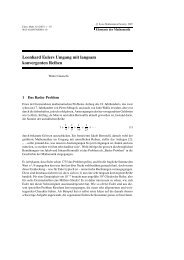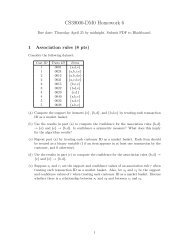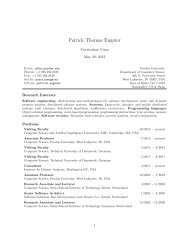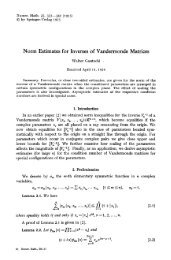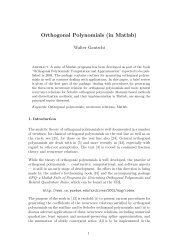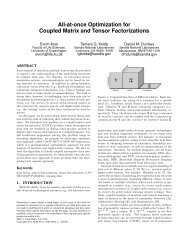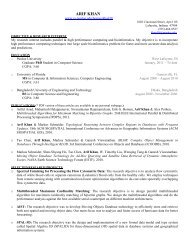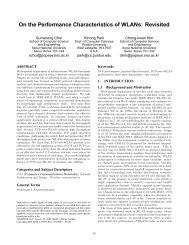CS 2003-2004 Faculty Information - Department of Computer ...
CS 2003-2004 Faculty Information - Department of Computer ...
CS 2003-2004 Faculty Information - Department of Computer ...
Create successful ePaper yourself
Turn your PDF publications into a flip-book with our unique Google optimized e-Paper software.
Daisuke Kihara<br />
Education:<br />
BS, Biochemistry, University <strong>of</strong> Tokyo, 1994<br />
MS, Bioinformatics, Kyoto University, 1996<br />
PhD, Bioinformatics, Kyoto University, 1999<br />
Positions:<br />
Assistant Pr<strong>of</strong>essor <strong>of</strong> <strong>Computer</strong> Science<br />
Assistant Pr<strong>of</strong>essor <strong>of</strong> Biological Sciences<br />
Bio-sketch:<br />
Dr. Kihara’s research interest is in the area <strong>of</strong> bioinformatics. In the last decade, a large amount <strong>of</strong> biological data, such<br />
as genome/protein sequences, protein 3D structures, and pathway data have become available. This data now enables<br />
us to employ comprehensive analysis <strong>of</strong> relationship between protein sequence, structure and function, evolution <strong>of</strong><br />
protein families, pathways, and organisms. Especially, he is focusing on developing computational methods to predict<br />
and analyze protein structure/function, pathway structure, and their applications in genome-scale or pathway/network<br />
scale. He has worked recently on protein structure prediction and comparison, development <strong>of</strong> prediction method <strong>of</strong><br />
transmembrane proteins, and its application to genome sequences.<br />
Selected Publications:<br />
Daisuke Kihara and Jeffrey Skolnick, “The PDB is a covering set <strong>of</strong> small protein structures,” Journal <strong>of</strong> Molecular<br />
Biology, Volume 334 pp. 793-802, <strong>2003</strong>.<br />
Daisuke Kihara, Yang Zhang, Hui Lu, Andrzej Kolinski, and Jeffrey Skolnick, “Ab initio Protein Structure Prediction<br />
on a Genomic Scale: Application to the Mycoplasma genitalium Genome,” Proceedings <strong>of</strong> the National Academy <strong>of</strong><br />
Sciences <strong>of</strong> the United States <strong>of</strong> America, Volume 99: pp. 5993-5998, 2002.<br />
Daisuke Kihara, Hui Lu, Andrzej Kolinski, and Jeffrey Skolnick, “TOUCHSTONE: An ab initio Protein Structure<br />
Prediction Method that Uses Threading-based Tertiary Restraints,” Proceedings <strong>of</strong> the National Academy <strong>of</strong> Sciences<br />
<strong>of</strong> the United States <strong>of</strong> America, Volume 98: pp. 10125-10130, 2001.<br />
Ninghui Li<br />
Education:<br />
BS, <strong>Computer</strong> Science, University <strong>of</strong> Science and Technology <strong>of</strong> China, 1993<br />
MS, <strong>Computer</strong> Science, New York University, 1998<br />
PhD, <strong>Computer</strong> Science, New York University, 2000<br />
Position:<br />
Assistant Pr<strong>of</strong>essor <strong>of</strong> <strong>Computer</strong> Science<br />
Bio-sketch:<br />
Pr<strong>of</strong>essor Ninghui Li joined Purdue in August <strong>2003</strong> as an assistant pr<strong>of</strong>essor in <strong>Computer</strong> Sciences. His research interests<br />
are in computer security and applied cryptography, e.g., security and privacy in distributed systems, networks,<br />
databases, and electronic commerce, with a focus on access control. One focus <strong>of</strong> Pr<strong>of</strong>essor Li’s work is on trust management,<br />
which is an approach to access control in decentralized, open, and distributed systems. He has designed,<br />
together with Pr<strong>of</strong>essors John Mitchell and Will Winsborough, the RT Role-based Trust-management framework,<br />
efficient goal-directed algorithms to do distributed credential chain discovery, logic-based semantic foundations for<br />
security policy languages, and algorithms and computational complexity characterization for analyzing properties <strong>of</strong><br />
security policies such as safety and availability.<br />
27



